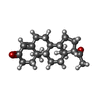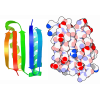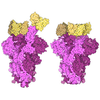+ データを開く
データを開く
- 基本情報
基本情報
| 登録情報 | データベース: PDB / ID: 9fkd | ||||||
|---|---|---|---|---|---|---|---|
| タイトル | Progesterone-bound DB3 Fab in complex with computationally designed DBPro1156_2 protein binder | ||||||
 要素 要素 |
| ||||||
 キーワード キーワード | DE NOVO PROTEIN / progesterone / binder / de novo / Fab / anti-kappa | ||||||
| 機能・相同性 | PROGESTERONE 機能・相同性情報 機能・相同性情報 | ||||||
| 生物種 | synthetic construct (人工物) | ||||||
| 手法 | 電子顕微鏡法 / 単粒子再構成法 / クライオ電子顕微鏡法 / 解像度: 3.3 Å | ||||||
 データ登録者 データ登録者 | Pacesa, M. / Marchand, A. / Correia, B.E. | ||||||
| 資金援助 |  スイス, 1件 スイス, 1件
| ||||||
 引用 引用 |  ジャーナル: Nature / 年: 2025 ジャーナル: Nature / 年: 2025タイトル: Targeting protein-ligand neosurfaces with a generalizable deep learning tool. 著者: Anthony Marchand / Stephen Buckley / Arne Schneuing / Martin Pacesa / Maddalena Elia / Pablo Gainza / Evgenia Elizarova / Rebecca M Neeser / Pao-Wan Lee / Luc Reymond / Yangyang Miao / Leo ...著者: Anthony Marchand / Stephen Buckley / Arne Schneuing / Martin Pacesa / Maddalena Elia / Pablo Gainza / Evgenia Elizarova / Rebecca M Neeser / Pao-Wan Lee / Luc Reymond / Yangyang Miao / Leo Scheller / Sandrine Georgeon / Joseph Schmidt / Philippe Schwaller / Sebastian J Maerkl / Michael Bronstein / Bruno E Correia /     要旨: Molecular recognition events between proteins drive biological processes in living systems. However, higher levels of mechanistic regulation have emerged, in which protein-protein interactions are ...Molecular recognition events between proteins drive biological processes in living systems. However, higher levels of mechanistic regulation have emerged, in which protein-protein interactions are conditioned to small molecules. Despite recent advances, computational tools for the design of new chemically induced protein interactions have remained a challenging task for the field. Here we present a computational strategy for the design of proteins that target neosurfaces, that is, surfaces arising from protein-ligand complexes. To develop this strategy, we leveraged a geometric deep learning approach based on learned molecular surface representations and experimentally validated binders against three drug-bound protein complexes: Bcl2-venetoclax, DB3-progesterone and PDF1-actinonin. All binders demonstrated high affinities and accurate specificities, as assessed by mutational and structural characterization. Remarkably, surface fingerprints previously trained only on proteins could be applied to neosurfaces induced by interactions with small molecules, providing a powerful demonstration of generalizability that is uncommon in other deep learning approaches. We anticipate that such designed chemically induced protein interactions will have the potential to expand the sensing repertoire and the assembly of new synthetic pathways in engineered cells for innovative drug-controlled cell-based therapies. | ||||||
| 履歴 |
|
- 構造の表示
構造の表示
| 構造ビューア | 分子:  Molmil Molmil Jmol/JSmol Jmol/JSmol |
|---|
- ダウンロードとリンク
ダウンロードとリンク
- ダウンロード
ダウンロード
| PDBx/mmCIF形式 |  9fkd.cif.gz 9fkd.cif.gz | 206.5 KB | 表示 |  PDBx/mmCIF形式 PDBx/mmCIF形式 |
|---|---|---|---|---|
| PDB形式 |  pdb9fkd.ent.gz pdb9fkd.ent.gz | 148.1 KB | 表示 |  PDB形式 PDB形式 |
| PDBx/mmJSON形式 |  9fkd.json.gz 9fkd.json.gz | ツリー表示 |  PDBx/mmJSON形式 PDBx/mmJSON形式 | |
| その他 |  その他のダウンロード その他のダウンロード |
-検証レポート
| 文書・要旨 |  9fkd_validation.pdf.gz 9fkd_validation.pdf.gz | 1.5 MB | 表示 |  wwPDB検証レポート wwPDB検証レポート |
|---|---|---|---|---|
| 文書・詳細版 |  9fkd_full_validation.pdf.gz 9fkd_full_validation.pdf.gz | 1.5 MB | 表示 | |
| XML形式データ |  9fkd_validation.xml.gz 9fkd_validation.xml.gz | 41.9 KB | 表示 | |
| CIF形式データ |  9fkd_validation.cif.gz 9fkd_validation.cif.gz | 63 KB | 表示 | |
| アーカイブディレクトリ |  https://data.pdbj.org/pub/pdb/validation_reports/fk/9fkd https://data.pdbj.org/pub/pdb/validation_reports/fk/9fkd ftp://data.pdbj.org/pub/pdb/validation_reports/fk/9fkd ftp://data.pdbj.org/pub/pdb/validation_reports/fk/9fkd | HTTPS FTP |
-関連構造データ
| 関連構造データ |  50522MC  8s1xC M: このデータのモデリングに利用したマップデータ C: 同じ文献を引用 ( |
|---|---|
| 類似構造データ | 類似検索 - 機能・相同性  F&H 検索 F&H 検索 |
- リンク
リンク
- 集合体
集合体
| 登録構造単位 | 
|
|---|---|
| 1 |
|
- 要素
要素
-抗体 , 4種, 4分子 HLKI
| #2: 抗体 | 分子量: 25930.930 Da / 分子数: 1 / 由来タイプ: 組換発現 / 由来: (組換発現) synthetic construct (人工物) / 発現宿主:  Homo sapiens (ヒト) Homo sapiens (ヒト) |
|---|---|
| #3: 抗体 | 分子量: 24332.191 Da / 分子数: 1 / 由来タイプ: 組換発現 / 由来: (組換発現) synthetic construct (人工物) / 発現宿主:  Homo sapiens (ヒト) Homo sapiens (ヒト) |
| #4: 抗体 | 分子量: 24115.680 Da / 分子数: 1 / 由来タイプ: 組換発現 / 由来: (組換発現) synthetic construct (人工物) / 発現宿主:  Homo sapiens (ヒト) Homo sapiens (ヒト) |
| #5: 抗体 | 分子量: 25346.602 Da / 分子数: 1 / 由来タイプ: 組換発現 / 由来: (組換発現) synthetic construct (人工物) / 発現宿主:  Homo sapiens (ヒト) Homo sapiens (ヒト) |
-タンパク質 / 非ポリマー , 2種, 2分子 B

| #1: タンパク質 | 分子量: 8087.193 Da / 分子数: 1 / 由来タイプ: 組換発現 / 由来: (組換発現) synthetic construct (人工物) / 発現宿主:  |
|---|---|
| #6: 化合物 | ChemComp-STR / |
-詳細
| 研究の焦点であるリガンドがあるか | Y |
|---|---|
| Has protein modification | Y |
-実験情報
-実験
| 実験 | 手法: 電子顕微鏡法 |
|---|---|
| EM実験 | 試料の集合状態: PARTICLE / 3次元再構成法: 単粒子再構成法 |
- 試料調製
試料調製
| 構成要素 | 名称: Progesterone-bound DB3 Fab in complex with computationally designed DBPro1156_2 protein binder タイプ: COMPLEX / Entity ID: #1-#5 / 由来: RECOMBINANT |
|---|---|
| 分子量 | 値: 0.10761566 MDa / 実験値: NO |
| 由来(天然) | 生物種: synthetic construct (人工物) |
| 由来(組換発現) | 生物種:  Homo sapiens (ヒト) Homo sapiens (ヒト) |
| 緩衝液 | pH: 7.5 |
| 試料 | 濃度: 3.9 mg/ml / 包埋: NO / シャドウイング: NO / 染色: NO / 凍結: YES 詳細: DB3 Fab and anti-Kappa Fab were pre-purified on SEC, while DBPro1156_2 de novo binder was added in 3-fold excess before grid freezing |
| 試料支持 | グリッドの材料: GOLD / グリッドのサイズ: 300 divisions/in. / グリッドのタイプ: Quantifoil |
| 急速凍結 | 装置: FEI VITROBOT MARK IV / 凍結剤: ETHANE / 湿度: 95 % / 凍結前の試料温度: 283.15 K |
- 電子顕微鏡撮影
電子顕微鏡撮影
| 実験機器 |  モデル: Titan Krios / 画像提供: FEI Company |
|---|---|
| 顕微鏡 | モデル: TFS KRIOS |
| 電子銃 | 電子線源:  FIELD EMISSION GUN / 加速電圧: 300 kV / 照射モード: FLOOD BEAM FIELD EMISSION GUN / 加速電圧: 300 kV / 照射モード: FLOOD BEAM |
| 電子レンズ | モード: BRIGHT FIELD / 最大 デフォーカス(公称値): 2400 nm / 最小 デフォーカス(公称値): 1200 nm / Cs: 2.7 mm / C2レンズ絞り径: 50 µm / アライメント法: COMA FREE |
| 試料ホルダ | 凍結剤: NITROGEN / 最高温度: 192 K / 最低温度: 186 K |
| 撮影 | 電子線照射量: 60 e/Å2 フィルム・検出器のモデル: FEI FALCON IV (4k x 4k) |
| 画像スキャン | 横: 4096 / 縦: 4096 |
- 解析
解析
| EMソフトウェア |
| ||||||||||||||||||||||||
|---|---|---|---|---|---|---|---|---|---|---|---|---|---|---|---|---|---|---|---|---|---|---|---|---|---|
| CTF補正 | タイプ: PHASE FLIPPING AND AMPLITUDE CORRECTION | ||||||||||||||||||||||||
| 粒子像の選択 | 選択した粒子像数: 4048193 | ||||||||||||||||||||||||
| 対称性 | 点対称性: C1 (非対称) | ||||||||||||||||||||||||
| 3次元再構成 | 解像度: 3.3 Å / 解像度の算出法: FSC 0.143 CUT-OFF / 粒子像の数: 192055 / クラス平均像の数: 1 / 対称性のタイプ: POINT | ||||||||||||||||||||||||
| 精密化 | 交差検証法: NONE |
 ムービー
ムービー コントローラー
コントローラー



 PDBj
PDBj



